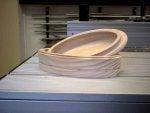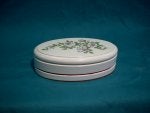especially where template guides and cutters are concerned. I asked Jim's advice as to what guides and cutters the average amateur routologist would be likely to have, so that I could produce another tutorial for beginners that was truly done the "American" way. Jim drew my attention to the fact that he couldn't find any metric guides on the net, so, not disbelieving him, but curious, I did a Google search with similar results, I did however find these two sites, the first offering a kit which contained both a 51/64" and a 1" as well as a 3/4", the last two of which I was hoping to base the next tutorial on, but the 51/64", how many of you have the means to measure in 64ths let alone calculate off-sets! I think that this unusual figure is close to 20mm and the 1 35/64" that I've seen several times is pretty close to 40mm, there we go, the wonderful 40mm guide that I'm always using. The second site actually sells a 40mm guide!
To those members who are/have become bored with my constant pushing of metric measurements, tough titty as an infamous follower of some Maharishi or other once replied when being interviewed on TV!
For members who can see the advantages of metric guides and cutters, make it known to retailers, distributors and even the actual manufacturers, or if you can't wait that long, perhaps you should have a go at OakPark, our sponsors who, I believe have equipment capable of making template guides! Have a good day my friends and fellow members.
http://www.woodworksupplies.com.au/category89_1.htm
http://www.festoolcanada.com/accessories/routers/template-guides-metric.html
To those members who are/have become bored with my constant pushing of metric measurements, tough titty as an infamous follower of some Maharishi or other once replied when being interviewed on TV!
For members who can see the advantages of metric guides and cutters, make it known to retailers, distributors and even the actual manufacturers, or if you can't wait that long, perhaps you should have a go at OakPark, our sponsors who, I believe have equipment capable of making template guides! Have a good day my friends and fellow members.
http://www.woodworksupplies.com.au/category89_1.htm
http://www.festoolcanada.com/accessories/routers/template-guides-metric.html







